![]()
![]()
![]()
Use LEFT and RIGHT arrow keys to navigate between flashcards;
Use UP and DOWN arrow keys to flip the card;
H to show hint;
A reads text to speech;
13 Cards in this Set
- Front
- Back
|
Mass spectrometer components |
Ionisation - molecules need to be charged, measurements as mass/charge (m/z) ratio Mass analyser - method to separate ions by mass Detector - interpret charges of ions as signals to be plotted on a mass spectra |
|
|
Electron impact |
Heat sample into gas phase Electron bombardment from rhenium/tungsten (70eV energy) Energy causes knocking electron out of sample giving an •M+ radical ion M + e- -> •M+ + 2e- Energy from bombardment often causes fragmentation of the sample molecule (70eV enough to break bonds of 5eV) Limited to small molecules up to 1000 Da |
|
|
MALDI |
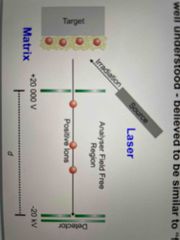
Laser at UV frequency fired at sample Sample is embedded in matrix which absorbs at the frequency of the laser (alpha-CHCA for peptides, 2, 5-DHB for carbohydrates) Energy absorbed from laser by matrix ionises sample MALDI gives high resolution due to delayed extraction - keep ion pulse in laser source after laser pulse so ions deep inside matrix can catch up to ions formed at the surface so ions of the same mass approach detector at the same velocity |
|
|
Electrospray |
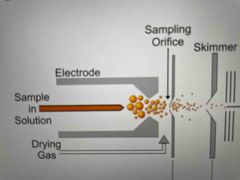
Done at atmospheric pressure Sample in solution introduced into ionisation source through a narrow capillary Capillary tip is coated with gold and has a high 2-4kV voltage applied for ionisation Droplets emerge from capillary and evaporate to reveal naked ions |
|
|
Electrospray |
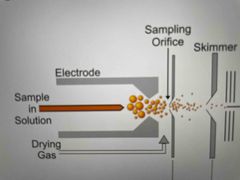
Done at atmospheric pressure Sample in solution introduced into ionisation source through a narrow capillary Capillary tip is coated with gold and has a high 2-4kV voltage applied for ionisation Droplets emerge from capillary and evaporate As the droplets evaporate, the charged ions get close together and ‘explode’ due to repulsion Ions often have multiple charge |
|
|
Quadrupole mass analyser |
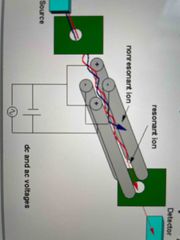
Rods diagonal to each other are connected diagonally Electric field is applied - rods have fixed DC and RF potentials Ions are passed through the middle off the rods Mass measured by stability of ion trajectory - ions of certain masses may travel off course and won’t reach the detector Positive net charge - larger ion trajectory more stable Negative net charge - smaller ion trajectory more stable |
|
|
Ion trap |

Like quadrupole mass analysers, electrodes use electric fields generated by RF or DC Electrodes are in a sandwich geometry so the mass analyser does not filter off ions Ions at certain m/z trapped inside electrode Different RF voltages scanned to eject ions of certain mass to be detected Linear ion traps with a larger linear volume improve resolution by reducing ion interference and increase storage capacity |
|
|
Orbitrap |
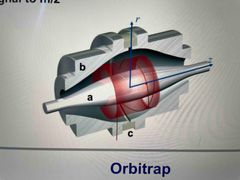
Ions are trapped in a static electrostatic field and orbit around a central electrode Ions oscillate in an axial direction M/z ratios are generated from Fourier transformation of this oscillation to the frequency domain |
|
|
Time of flight |

Ions travel inside charged chamber in a straight line towards the detector Ions are separated by velocity - smaller ions reach the detector first Modern TOF analysers have reflectrons- ion mirrors reverse direction of travel to ensure all ions of the same mass travel at the same velocity |
|
|
Ion detectors |
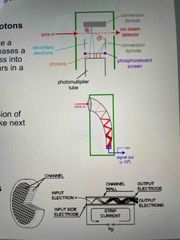
Photomultiplier - ions strike a dynode causing electron emission. Electrons then strike a phosphorescent screen to release a burst of photons which pass pass through a multiplier for detection Electron multiplier - ion strikes a dynode causing electron emission. Electrons continue to strike dynodes. As dynodes are struck, signal amplifies to allow detection Micro channel plate array - allows multiple m/z values to be detected |
|
|
Sample fragmentation for MS |
Useful for structural determination - even larger molecules like peptides and glycans can be sequenced Mostly occurs in electron impact but limited to smaller molecules. Molecular ions rarely observed Ions formed by MALDI or electrospray need collisional activation by inert gas to generate fragments for analysis by MS/MS Multiple charged molecular ions from electrospray have lower collisional energy than singly charged ions. Fragments after bombardment are normally singly charged |
|
|
MS based peptide sequencing |
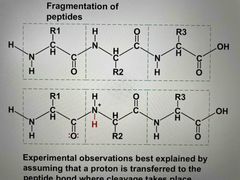
Assumption that a proton is transferred to the peptide bond where cleavage occurs N terminal B ions - generated by transferring carbonyl oxygen electrons to the carbonyl pi system then breaking the peptide bond A ions can be generated from B ions by forming a double bond between the amine and alpha carbon then expelling CO C terminal Y ions - generated by transferring alpha hydrogen of previous residue to protonated amine then cleaving the peptide bond Trypsin often used to digest peptides as C terminal residue/smallest ion will always be arginine or lysine which shouldn’t be found within peptides Sequence by finding y ions then smallest b ions then b/a ions |
|
|
MS glycomic sequencing |
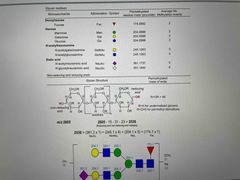
Permethylation - replacing OH and N-acetyl with methyl to improve glycan ionisation efficiency and allow detection of both neutral and acidic glycans Sum of permethylated mass ends is 46 |

